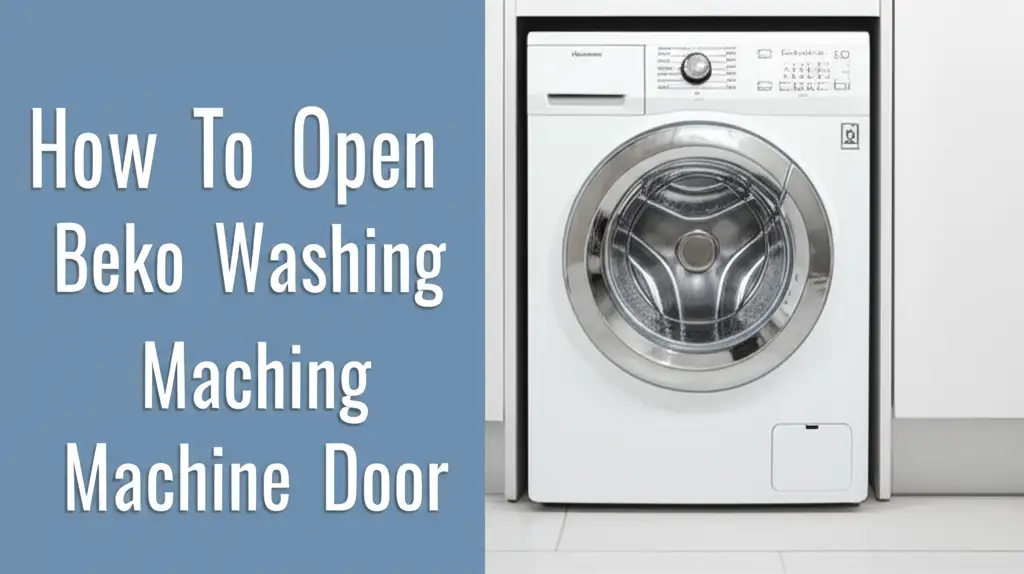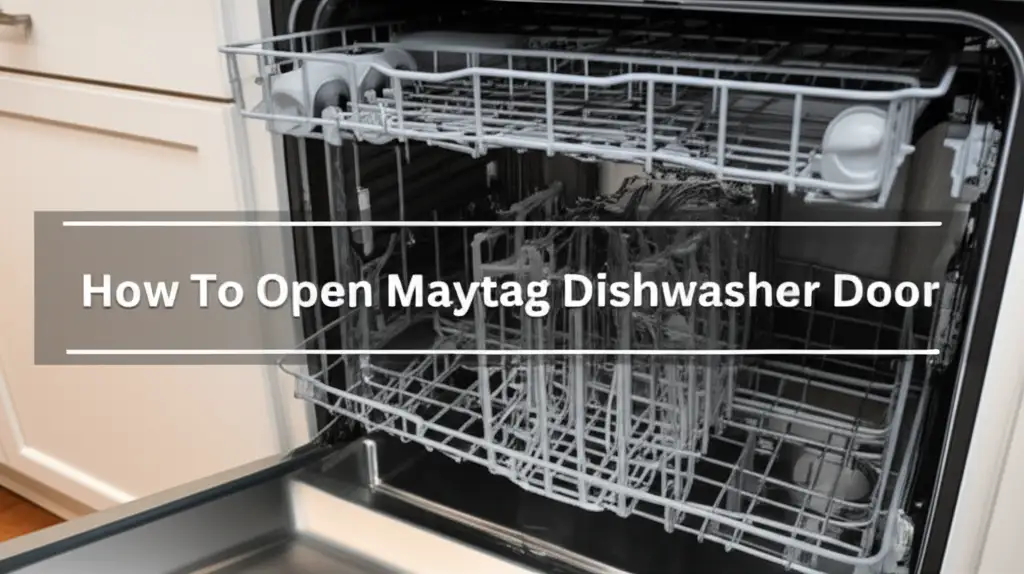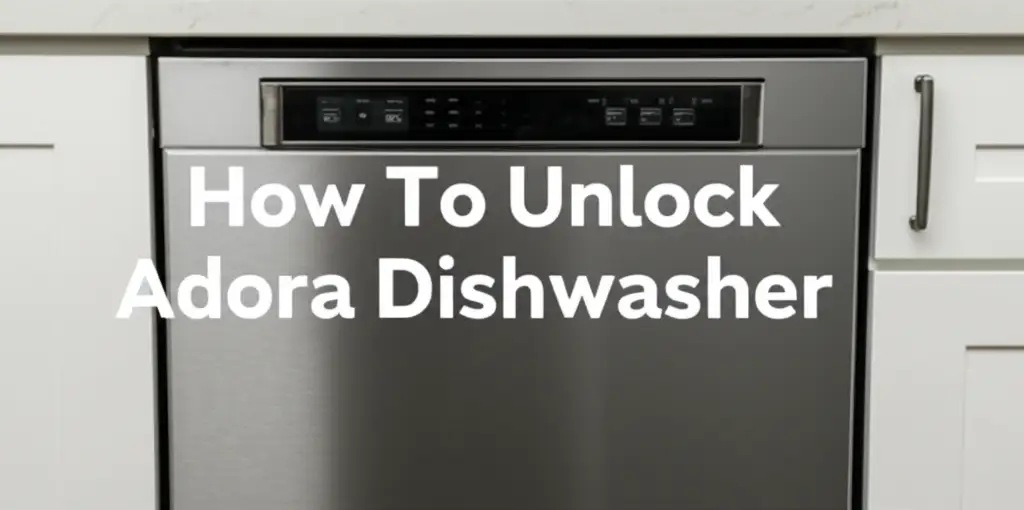· Tessa Winslow · Appliance Troubleshooting · 18 min read
How To Open Beko Washing Machine Door

How To Open Beko Washing Machine Door Safely
My washing machine door sometimes refuses to budge. It is a common problem. We load our laundry, start a cycle, and then the door stays stubbornly locked. This situation feels frustrating, especially with wet clothes trapped inside. You might wonder, “How to open Beko washing machine door?” This guide helps you.
This article explores various methods to safely open your Beko washing machine door. We cover issues like power failures, drainage problems, and faulty door locks. You will learn quick checks, emergency release procedures, and prevention tips. My goal is to help you get your laundry out and your machine working right.
Takeaway
- Always check power, cycle status, and water levels first.
- Use the emergency release cord only after ensuring power is off and water is drained.
- Never force a locked door; this causes more damage.
- Regular maintenance helps prevent future door lock issues.
- Call a professional if the problem persists or seems complex.
You can open a Beko washing machine door by first checking power and cycle status. If water remains, drain it via the filter. For a stuck lock, try the emergency release cord, usually found near the drain filter at the bottom front of the machine.
Understanding Your Beko Washing Machine Door Lock System
Beko washing machines feature a robust door lock system. This system ensures user safety during operation. The door locks once a cycle starts. It remains locked until the cycle finishes and the internal components cool down. This design prevents accidental opening while hot water or high-speed spinning occurs.
The main component is the door interlock mechanism. This part has a small pin that slides into a slot on the door. It holds the door firmly shut. Electrical signals control this pin. If power fails or a fault occurs, the pin may not retract. This keeps the door locked. Understanding this system helps when troubleshooting.
The Door Interlock Mechanism
The door interlock is a crucial safety device. It prevents the door from opening when water is inside or the drum is spinning. The machine’s control board sends a signal to the interlock. This signal tells it to lock or unlock. If the signal is missing or the interlock fails, the door stays shut. This mechanism protects you from water spills and moving parts.
Sometimes, the interlock needs a few minutes to reset. After a cycle ends, wait for the clicking sound. This sound means the interlock has disengaged. It is a normal part of the machine’s operation. Patience is key. If you are handy with tools, you might even consider some do it yourself washing machine fixes for minor issues.
Common Door Lock Indicators
Your Beko washing machine might show specific indicators. A flashing lock symbol on the display often means the door is not fully closed. It can also mean the lock is engaged during a cycle. If the symbol stays lit after the cycle, it suggests a lock issue. Other signs include the machine not starting at all.
Listen for unusual sounds too. A constant clicking without the door unlocking suggests a faulty interlock. No sound at all might mean a power problem to the lock. These indicators guide your troubleshooting steps. They help you pinpoint the exact problem.
Immediate Checks Before Attempting to Open Your Beko Washer Door
Before you try more advanced methods, perform some basic checks. These steps often resolve the issue quickly. They also ensure your safety. Forcing a locked door can cause significant damage. This damage often costs more to repair than a simple fix.
I always start here when my machine acts up. It saves time and prevents headaches. These checks ensure the machine is in a safe state to work with. They help rule out common, simple problems.
Verifying Power Supply
First, check the power. Your Beko washing machine door needs electricity to unlock. Is the machine plugged in? Has a circuit breaker tripped? Unplug the machine for 5-10 minutes. Then plug it back in. This simple power reset can clear minor electronic glitches.
If the power is out in your home, the door will remain locked. Washing machines rely on power to operate the door lock. Wait for power to return. Then, the door should unlock automatically. If it doesn’t, proceed to other steps.
Checking Cycle Completion
The door lock stays engaged throughout a wash cycle. It also stays locked during spin and drain cycles. Ensure the cycle has fully finished. Many machines have a delay before the door unlocks. This delay allows the drum to stop completely. It also lets water drain away.
Wait 5-10 minutes after the cycle ends. Listen for a click. This click indicates the door interlock has disengaged. If the machine display still shows a program running, cancel the program. Press and hold the “Start/Pause” button for a few seconds. This action often resets the machine.
Assessing Water Levels
A Beko washing machine door will not open if there is water inside. This is a safety feature. Check if you see water in the drum. If water remains, the machine will keep the door locked. This prevents spills and flooding.
You need to drain the water first. Most Beko machines have a drain filter at the bottom front. This filter usually has a small hose next to it. You can use this hose to manually drain the water. Draining excess water is a crucial step for opening the door safely. This process is similar to how you might need to unblock a washing machine when it fails to drain properly.
Safely Opening a Beko Washing Machine Door After Power Failure
A sudden power cut often leaves your Beko washing machine door locked. This happens because the door lock is an electronic component. It needs electricity to release its mechanism. Do not panic. There are safe ways to open it.
My power went out once mid-cycle. I thought my clothes were trapped for good. But with a little patience and the right steps, the door opened right up. This process is straightforward.
The Waiting Game
After a power failure, your Beko machine may need time. The internal safety mechanisms must reset. The door interlock often has a thermal release. This means it unlocks once it cools down. Give it at least 5-10 minutes.
During this waiting period, avoid pressing buttons repeatedly. This can confuse the machine’s electronics further. Just let it sit. The machine might reset itself when power returns. If it does not, you will need to try the manual release.
Locating the Emergency Release Pull
Most Beko washing machines have an emergency door release. This is a manual override. It is usually located at the bottom front of the machine. You will need to open the small service panel. This panel is where the drain filter is.
Look for a small plastic tab or a ring-shaped cord. It might be red or orange. This is your emergency release. Always ensure there is no water in the machine before using this. Opening the door with water inside will cause a flood. This is a similar concept to opening doors on other appliances, like when you how to remove wall oven door for maintenance, where specific steps are needed for safe removal.
Executing the Manual Release
To use the emergency release:
- Switch off and unplug: Turn off the washing machine and unplug it from the wall socket. This step is critical for your safety.
- Access the service panel: Open the small cover at the bottom front of the machine. You might need a flat-head screwdriver.
- Prepare for water (if any): Place a shallow tray and towels underneath the panel. Even if you drained, some residual water might leak out.
- Locate and pull: Find the small tab or cord. Gently pull it downwards or outwards. You might hear a click. This click means the door lock has disengaged.
- Open the door: The door should now open. Do not force it if it still feels stuck. Recheck for water or other issues.
Be gentle. Pulling too hard can break the release mechanism. If the door does not open, check if the tab or cord fully moved.
Troubleshooting a Beko Washing Machine Door That Won’t Open Due to Water
A locked door often indicates water trapped inside. Your Beko machine locks the door as a safety measure. This prevents water from spilling onto your floor. If you see water in the drum, you must drain it first.
I have faced this issue many times. It is usually an easy fix once you understand the drainage system. Proper drainage ensures the machine can unlock its door.
Draining Your Beko Washer
Most Beko washing machines have a drain filter and small drain hose at the bottom front. This setup allows for manual draining. You will need a shallow basin or towel to catch the water.
- Power off: Turn off and unplug the machine. Safety is key.
- Access panel: Open the service panel at the bottom front.
- Position basin: Place a shallow tray or basin directly under the small drain hose.
- Release hose: Pull out the small drain hose and remove its cap. Water will start to flow out.
- Drain fully: Let all the water drain into your basin. This might take a few minutes.
Once empty, cap the hose and place it back. The door should then unlock.
Cleaning the Drain Filter
A blocked drain filter is a common cause of water retention. Lint, coins, or small objects can clog it. This prevents proper drainage.
- Drain water first: Ensure all water is drained using the small hose as described above.
- Unscrew filter: Once drained, unscrew the large circular drain filter. Turn it counter-clockwise.
- Remove debris: Pull out the filter carefully. Clean off any lint, coins, or foreign objects. Inspect the filter housing for debris too.
- Rinse and reinsert: Rinse the filter under running water. Screw it back in tightly. Ensure a snug fit to prevent leaks.
Cleaning the drain filter regularly prevents these issues. I recommend cleaning it every few months. This process is part of general washing machine maintenance, much like keeping other appliances clean, as outlined in articles such as how to clean lg he washing machine.
Checking the Drain Pump
If draining the filter does not work, the drain pump might be faulty. The pump pushes water out of the machine. If it is broken, water stays inside. This keeps the door locked. You might hear a humming sound but no water movement.
Checking the drain pump usually requires disassembling parts of the machine. This step is more complex. If you suspect a faulty pump, consider calling a qualified technician. They have the tools and expertise to diagnose and replace it safely.
Dealing with a Faulty Door Lock on Your Beko Washing Machine
Sometimes, the door remains locked even with no water and power on. This often points to a faulty door lock mechanism. The lock can wear out over time. Electrical faults or physical damage can also cause it to fail. Identifying this problem helps you decide your next steps.
I once had a machine where the lock just clicked endlessly. It was clear the mechanism itself was the issue. This is different from simple power or water issues.
Identifying Lock Malfunctions
A faulty door lock often shows specific symptoms.
- No click: When you try to start a cycle or open the door, you hear no click from the lock. This suggests no power reaches it.
- Constant clicking: The lock clicks repeatedly but does not engage or disengage. This indicates a mechanical fault within the lock.
- Error codes: Your Beko washing machine display might show an error code related to the door lock. Consult your user manual for the meaning of these codes.
- Door feels loose: The door might feel loose but still not open. This implies the latch is not fully engaged or disengaged.
These signs tell you the problem lies with the door lock itself. This is similar to how a malfunctioning door switch on a dishwasher prevents it from operating correctly.
Gentle Persuasion Techniques
Sometimes, you can encourage a sticky door lock to release. This requires gentle action.
- Power off: Unplug the machine.
- Push and pull: Apply gentle pressure to the door. Push it firmly inwards, then gently pull it outwards. Do this a few times. This action might help free a sticking latch.
- Wiggle and tap: Lightly wiggle the door while applying gentle outward pressure. You can also tap around the lock area. Use the palm of your hand, not a tool. This might dislodge any minor obstruction.
- Restart cycle: If the door opens, try restarting a short rinse or spin cycle. This helps confirm the lock is working. If it locks again and refuses to open, the lock needs replacement.
Never use excessive force. Forcing the door can break the door handle, the lock, or even damage the machine’s frame. This turns a simple repair into a costly one. If gentle methods fail, the lock likely needs professional attention.
When to Call a Technician
If the door remains stubbornly locked after all your attempts, it is time for professional help. A qualified appliance technician can diagnose the problem accurately. They have specialized tools and replacement parts. Attempting complex repairs yourself without proper knowledge risks further damage.
Look for technicians specializing in Beko appliances. They understand the specific mechanisms of your machine. Explain all the steps you have already tried. This helps them quickly assess the situation. A professional ensures your machine gets fixed safely and correctly.
Emergency Door Release for Beko Washing Machine Models
Beko washing machines, like most modern appliances, include an emergency door release. This feature is a crucial safety bypass. It allows you to open the door manually when electronic systems fail. Knowing its location and proper use is essential.
My machine’s door got stuck once due to a power surge. The emergency release was a lifesaver. It allowed me to retrieve my wet clothes. This feature is designed for situations where electronic unlocking is not possible.
Accessing the Service Panel
The emergency release mechanism is almost always located behind a small service panel. This panel is typically at the bottom front of your Beko washing machine.
- Locate the panel: It is usually a square or rectangular plastic cover. It sits near the floor.
- Open the panel: Use a flat-head screwdriver or your fingers to pry open the cover. Some panels have a push-to-open latch.
- Clear the area: Ensure the area around the panel is clear. Have a towel ready. You might encounter a small amount of water.
Once the panel is open, you will see the drain filter. The emergency release is usually near this filter. It often looks like a small tab or a loop of wire.
Executing the Manual Release
Follow these steps carefully to use the emergency release:
- Ensure no water: Confirm there is no water visible in the drum. If there is water, use the small drain hose next to the filter to empty it first. This step is vital to avoid flooding your floor.
- Unplug machine: Always unplug the Beko washing machine from the power outlet. This eliminates any risk of electrical shock.
- Locate the release: Look inside the service panel. Find the small plastic tab, lever, or wire loop. It is often colored brightly, like red or orange. It will be near the door lock assembly or the drain filter.
- Pull gently: Gently pull the tab or loop downwards or towards you. You should hear a distinct click as the door lock disengages. Do not pull with excessive force. This can break the mechanism.
- Open the door: Once you hear the click, try to open the washing machine door. It should now release.
If the door still does not open, gently push it inwards, then pull it again. Sometimes, the latch needs a little nudge. If the door remains locked after these steps, the issue might be more complex than a simple lock jam. It may indicate a broken door handle, latch, or a more serious electrical fault. In such cases, professional assistance is recommended.
Preventing Future Beko Washing Machine Door Lock Issues
Prevention is always better than a fix. Taking simple steps can extend the life of your Beko washing machine’s door lock. These actions reduce the chance of future door issues. Regular care helps your appliance run smoothly for years.
I make these checks part of my routine. It saves me from the frustration of a locked door. Keeping your machine in good shape prevents many common problems.
Best Practices for Door Care
Proper use of the door protects its components.
- Avoid slamming: Gently close the door. Slamming it puts stress on the latch and hinges. Over time, this causes misalignment or breakage.
- Do not overload: An overloaded machine puts pressure on the door. It can cause the door to bulge slightly. This prevents the lock from engaging or disengaging correctly. Follow your Beko machine’s capacity guidelines.
- Check for trapped items: Before closing the door, check for clothes caught in the door seal. Items trapped there prevent the door from closing fully. This stops the lock from engaging.
These simple habits make a big difference. They ensure the door and its lock function as intended.
Routine Maintenance Schedule
Regular maintenance extends the life of your Beko washing machine’s door lock and other parts.
- Clean the door seal: Mold and mildew can build up on the door seal. This gunk can create friction. Wipe the seal after each wash. Use a mild detergent or a specialized washing machine cleaner. This is similar to routine cleaning needed for any appliance, like how to clean top loader washing machine models.
- Inspect hinges: Periodically check the door hinges for tightness. Loose hinges can cause the door to sag. A sagging door misaligns with the lock. Tighten any loose screws.
- Lubricate the latch (carefully): A tiny bit of silicone spray or petroleum jelly on the latch mechanism can keep it smooth. Do this sparingly. Avoid getting lubricant on electronic parts.
These maintenance tasks are easy to do. They help prevent mechanical failures in the door lock system. A well-maintained machine is a happy machine.
Frequently Asked Questions
Why does my Beko washing machine door stay locked after a cycle?
Your Beko washing machine door stays locked after a cycle for several reasons. The most common is a safety delay. The machine waits for the drum to stop spinning and for water to drain. If water remains, or if there’s a fault with the door lock itself, it will stay locked. Power outages can also cause this.
Can I force open a Beko washing machine door?
No, you must never force open a Beko washing machine door. Forcing it can severely damage the door handle, the door lock mechanism, or even the machine’s body. This will lead to more expensive repairs. Always use the gentle troubleshooting steps or the emergency release.
Where is the emergency release on a Beko washing machine?
The emergency release on most Beko washing machines is at the bottom front. It is usually behind a small service panel or kick plate. You will find a small plastic tab or a ring-shaped cord, often colored red or orange. Pulling this manually disengages the door lock.
What if there’s still water in the machine, and the door won’t open?
If water remains and the door won’t open, you must drain the water first. Access the drain filter and the small drain hose at the bottom front of your Beko machine. Use this hose to manually drain all the water into a basin. After draining, the door should unlock.
How do I know if my Beko door lock is broken?
A broken Beko door lock might show specific signs. You may hear constant clicking sounds from the lock but the door does not open or close. The machine might display an error code related to the door. Or, the machine might not start a cycle at all because it cannot detect the door is properly locked.
Does a Beko washing machine door unlock immediately after the cycle ends?
No, a Beko washing machine door does not typically unlock immediately after the cycle ends. There is usually a short delay. This delay allows the drum to completely stop spinning and ensures all water has drained. This is a safety feature to prevent injuries or spills. Wait a few minutes after the cycle light goes out.
Conclusion
Opening a stuck Beko washing machine door can feel like a big challenge. However, with the right approach, you can usually solve it safely. We have covered checking the power, confirming the cycle status, and draining any residual water. We explored using the emergency release and addressing faulty door locks. These steps empower you to handle common door lock issues.
Remember, never force the door open. That action causes more damage. If you have tried all the steps and your Beko washing machine door still won’t open, contact a professional technician. They can diagnose complex problems. By following these guidelines, you keep your appliance running smoothly. Share your own tips for opening a Beko washing machine door in the comments. We love to hear from you!





